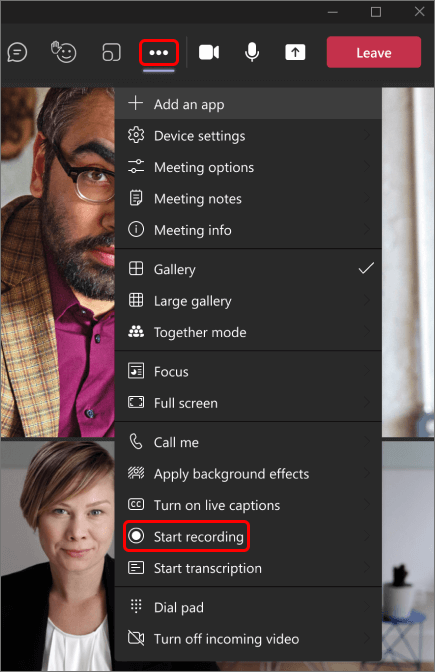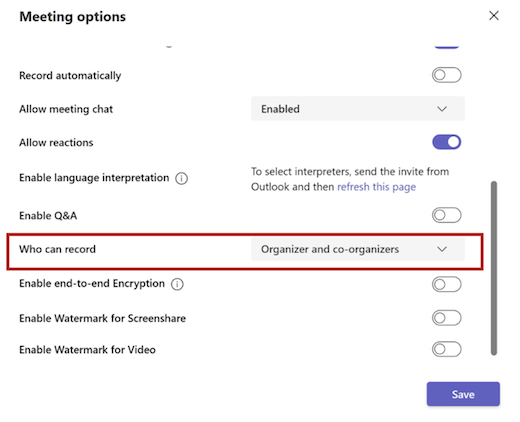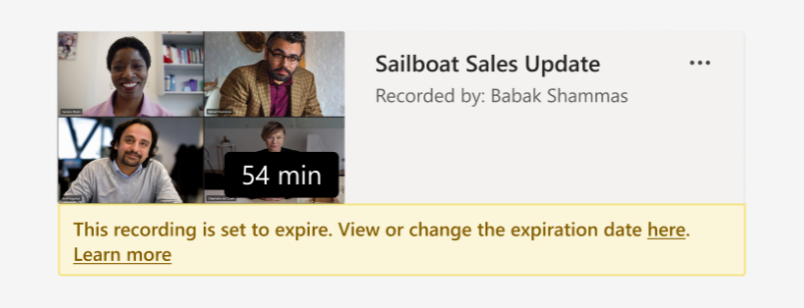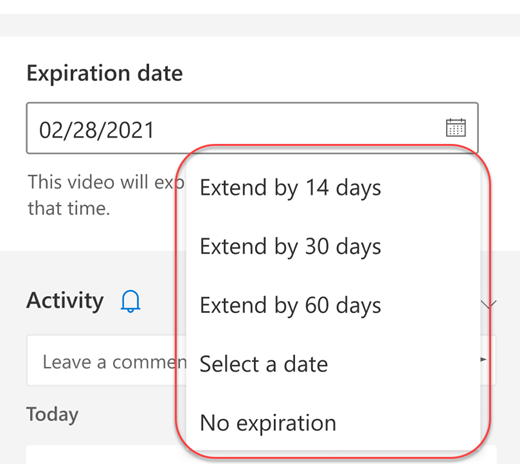Start recording
When you start recording a meeting, you also turn on live transcriptions (if your IT admin allows transcriptions).
-
Start or join the meeting.
-
Go to the meeting controls and select More actions  > Start recording.
> Start recording.

Everyone in the meeting gets notified that recording and transcription have started.

Notes:
-
You can't make multiple recordings of the same meeting at the same time. If one person starts recording a meeting, that recording will be stored on the cloud and available to all participants.
-
Meeting participants have the option of viewing the transcription during the meeting. For details, see view live transcription.
Stop recording
-
Go to the meeting controls and select More actions  .
.
-
Choose one of the following:
Find recordings
Recordings are available in different places depending on the type of meeting.
-
The recording is processed and saved to SharePoint if it was a channel meeting or OneDrive if it was any other type of meeting.
-
The meeting recording shows up in the meeting chat or channel conversation (if you’re meeting in a channel).
Note: For now, guests and external attendees can view the recording only if it's explicitly shared with them.
Who can start or stop a recording?
Anyone who meets the following criteria can start or stop a recording, even if the meeting organizer isn't present, as long as the meeting organizer has their cloud recording policy setting turned on.
-
Has one of the following licenses: Office 365 Enterprise E1, E3, E5, F3, A1, A3, A5, M365 Business, Business Premium, or Business Essentials.
-
Has recording enabled by an IT admin.
-
Isn't a guest or from another organization.
|
Type of user
|
Can start recording?
|
Can stop recording?
|
|
Meeting organizer
|
|
|
|
Person from same org
|
|
|
|
Person from another org or company
|
|
|
|
Guest
|
|
|
|
Anonymous
|
|
|
Notes:
-
Recording continues even if the person who started the recording has left the meeting.
-
The recording stops automatically once everyone leaves the meeting. If someone forgets to leave, the recording automatically ends after four hours.
-
If one of the participants has a policy for compliance recording, the meeting will be recorded according to the policy even if that participant is from another org.
With Teams Premium, meeting organizers can easily manage who can record when scheduling Teams meetings. There are two options for who can record a meeting: organizers and co-organizers, or organizers and presenters.
See Roles in a Teams meeting for details about selecting presenters and changing someone's role before and during a meeting.
Note: Teams Premium is an add-on license that provides additional features to make Teams meetings more personalized, intelligent, and secure. To get access to this license, contact your IT admin.
-
Go to Calendar on the left side of the app and select New meeting in the top right corner.
-
Invite people to the meeting.
-
In the meeting invitation, select Meeting options.
-
Set meeting participants as presenters and co-organizers, as necessary.
-
Next to Who can record, select an option from the dropdown menu.

6. Select Save and then send the meeting invite.
Manage the expiration of a meeting recording
Your admin's settings determine whether (and when) a recording will expire. If your recording has an expiration date, you'll see a message indicating that when the recording pops into the meeting chat after the meeting ends.

Open the details pane to view or change the expiration date.
There are a couple of different ways to get there:
-
Click on the recording to open it in your browser. Once the browser page has opened, select  in the upper right to open the details pane.
in the upper right to open the details pane.
-
Or, go to My files in your OneDrive or SharePoint site and view as a list. Mouse over the recording in question, select Show actions (the three vertical dots to the right of the file name), and then choose Details.
When the details pane is open, look for Expiration date. Here's where you'll see the date that's currently set.

Open the drop-down to see your options for changing the date. Extend the recording's availability for a certain number of days, or pick a specific date on the calendar. You can also choose No expiration if you don't want it to be deleted.
